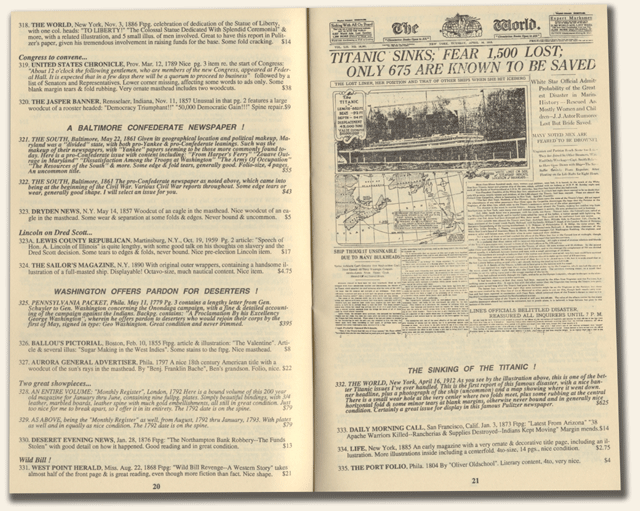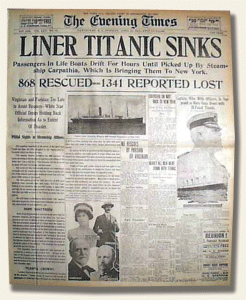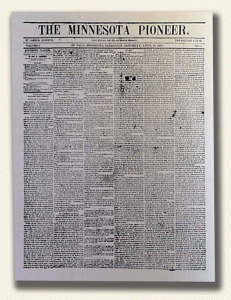Prices… a walk down memory lane… 1987…
October 25, 2010 by GuyHeilenman · Leave a Comment
Blondie, Kool & the Gang, Ambrosia… Rubik’s Cube, Break Dancing, Transformers… The A-Team, 21 Jump Street, Moonlighting… the 80’s! Our walk through time now brings us to the 8o’s. Our exploration of authentic newspaper pricing through time takes us back to Catalog 60. To see a larger image of the catalog’s page, go here: Catalog 60
Prices… a walk down memory lane… 1993…
October 18, 2010 by GuyHeilenman · 2 Comments
Forest Gump, Jerry Maguire, Smashing Pumpkins, Nirvana… the 90’s. Our price-searching through time continues… all the way to “back in the day”… when everything was “aiight. Over the past few weeks we’ve looked at sample prices from 2006 and 2009. Today we explore a half-dozen years earlier – 1993. To see a larger image of the catalog’s page, go here: Catalog 90
Prices… a walk down memory lane… 1999…
October 11, 2010 by GuyHeilenman · Leave a Comment
A week ago we looked at authentic newspaper prices from 2006. Today will go a little farther back in time… to 1999. To see a larger image of the catalog’s page, go to: Catalog 120
Prices… a walk down memory lane… 2006…
October 4, 2010 by GuyHeilenman · Leave a Comment
We recently took a look at “prices realized” for a number of historic newspapers spanning the centuries. We’ll now take a look a the pricing of authentic newspapers from a different perspective: pricing over time. Over the course of the next several weeks we’ll post a random page from old Rare & Early Newspapers catalogs. We’ll start with a page from a catalog sent in 2006, and work backwards through time.
Prices realized… 20th century…
September 27, 2010 by GuyHeilenman · 1 Comment
We continue with our series on “prices realized”, with this 4th installment providing select examples of issues from the 20th century. While there are many issues to choose from, we tried to cover a variety of collectible interests.
 Note: While collectible newspapers have had a good track record of increasing in value over time (see upcoming posts), we encourage hobbyists to collect for non-financial reasons. History in your hands…
Note: While collectible newspapers have had a good track record of increasing in value over time (see upcoming posts), we encourage hobbyists to collect for non-financial reasons. History in your hands…
20th century selections:
The previous posts in this series are:
Prices realized… 16th & 17th centuries…
Prices realized… 18th century…
Prices realized… 19th century…
Collecting Historic and Rare Newspapers Basics – Part One
August 2, 2010 by GuyHeilenman · 14 Comments
The following guide is posted on History’s Newsstand’s eBay Store. It is the first part of a primer on collecting Rare & Early Newspapers:
 The purpose of this guide concerning historic, original, collectible and/or rare newspapers is to answer the three most common questions related to the hobby: How you can determine if an issue is authentic, the meaning of commonly used terms related to the hobby, and why the original issues do not just fall apart.
The purpose of this guide concerning historic, original, collectible and/or rare newspapers is to answer the three most common questions related to the hobby: How you can determine if an issue is authentic, the meaning of commonly used terms related to the hobby, and why the original issues do not just fall apart.
How Can You Determine If An Issue Is Authentic?
It was not unusual for newspapers to celebrate the anniversary of an historic event or their inaugural issue by reprinting that issue for their subscribers or the general public. Never meant to deceive, through the years such issues were tucked away in attics and dresser drawers as interesting souvenirs only to be uncovered by distant relatives convinced they found the genuine item.
Although only an expert examination can definitively qualify a newspaper as genuine or a reprint and such experts with sufficient knowledge & experience are few & far between, there are a few clues which can guide a novice in making a determination:
* Does the newsprint match that used at that time? Genuine pre-1880 newsprint usually has a high rag content and is very pliable, sturdy & reasonably white. Most reprints in the post-1880 era are more browned, fragile and lacking in physical substance.
* Does the issue contain an historic or significant report? Many reprints contain very historic reports rather than mundane news of the day, and such genuine issues are rarely found randomly outside of a larger collection.
* Is the issue a volume one, number one issue? They were commonly reprinted on anniversary dates.
* Does the format, content or any extraneous printing on the issue appear out of the ordinary? Many reprints were used for promotional purposes and altered to serve another purpose beyond just reprinting a genuine newspaper.
Reprint, fake, or facsimile newspapers are a rarity in this hobby with the vast majority of such issues limited to less than 20 titles. The Library of Congress maintains a check-list of points to look for on most of these issues and can be accessed through their website.
What Are The Most Frequently Used Terms & What Do They Mean?
* Octavo (8vo): Approximately 8 1/2 by 5 inches. Popular size for 18th Century magazines.
* Quarto (4to): Approximately 12 by 9 inches. Common size for many early newspapers.
* Folio: Full size. Eighteenth century issues are approximately 17 by 11 inches, while 19th century issues come closer to present day newspapers.
* Foxing: Dark spots due to age, chemical content of the paper, or storage environment.
* dblpgctrfld: Doublepage centerfold. A print, typical in Harper’s Weekly, which stretches across two pages.
Why Do The Issues Simply Not Fall Apart?
To the surprise of many, newspapers published before 1880 remain in very nice condition as the paper had high cotton and linen content. Most issues from the 1600’s and 1700’s are in much better condition than issues from World War I, hence little care is needed for issues over 120 years old.
(Note) Invitation: In order to provide an ongoing resource for newcomers to the hobby, feel free to add additional insight which you feel might be beneficial to those entering the hobby on the ground floor. Our hope will be to include many of these comments within a future post. Thanks in advance for your contributions.
Minnesota’s first newspapers…
June 21, 2010 by TimHughes · 3 Comments
 The first “Minnesota” newspaper has the curious distinction of never being printed in Minnesota. Dr. Andrew Randall, a U.S. government employee from Ohio engaged in a geological survey of the Minnesota district, decided to become a printer. He returned to his home town of Cincinnati, purchased printing equipment, and produced in Cincinnati the volume 1, number 1 issue of the “Minnesota Register“. There was but one number, but existing copies bear different dates of April 7 and 27, 1849.
The first “Minnesota” newspaper has the curious distinction of never being printed in Minnesota. Dr. Andrew Randall, a U.S. government employee from Ohio engaged in a geological survey of the Minnesota district, decided to become a printer. He returned to his home town of Cincinnati, purchased printing equipment, and produced in Cincinnati the volume 1, number 1 issue of the “Minnesota Register“. There was but one number, but existing copies bear different dates of April 7 and 27, 1849.
Another outsider, James Goodhue, a lawyer-turned printer from Lancaster, Wisconsin, worked for a newspaper in Wisconsin before carting his equipment and heading north for St. Paul’s Landing in the Minnesota Territory. There he planed on printing what was to be named the “Epistle of St. Paul”, but after advice of friends the first issue was actually titled the “Minnesota Pioneer“, appearing on April 28, 1849. Not only was this the first newspaper actually printed in Minnesota, it was the first piece of any printing done in the territory.
The next newspaper was done by another Ohioan, James Hughes, who on May 31, 1849 printed the “Minnesota Chronicle” on May 31, 1849. Third in line was the “Minnesota Register“, now moved from Cincinnati to Minnesota to become a legitimate Minnesota newspaper when it printed its July 14, 1849 issue in St. Paul. Just over a month later the “Chronicle” and “Register” combined to produce the “Chronicle & Register” on August 25.
Digital newspaper archives…
May 27, 2010 by GuyHeilenman · 1 Comment
 Many collectors of historic newspapers often collect issues based upon desired content. If the content is relatively common or is within a clearly defined (and small) time frame, finding issues to collect may not be too difficult. However, if the desired content appeared within issues only occasionally and/or over large spans of time, finding desired issues can be quite difficult. For example, if someone is looking for issues with Moon landing content, since the dates are precise, the task of location issues can be easy. In contrast, if what is being collected are pre-1800 mentions of Georgia, the task can be quite daunting.
Many collectors of historic newspapers often collect issues based upon desired content. If the content is relatively common or is within a clearly defined (and small) time frame, finding issues to collect may not be too difficult. However, if the desired content appeared within issues only occasionally and/or over large spans of time, finding desired issues can be quite difficult. For example, if someone is looking for issues with Moon landing content, since the dates are precise, the task of location issues can be easy. In contrast, if what is being collected are pre-1800 mentions of Georgia, the task can be quite daunting.
However, with the continued growth of the internet also comes ever increasing access to digital archives of newspapers from throughout the world. While some are only available for a fee, the quantity of free archives continues to soar. Wikipedia has begun to assemble a list of both types. It can be viewed at:
Wikipedia: List of online newspaper archives
The Civil War…
April 1, 2010 by GuyHeilenman · Leave a Comment
 Not too long ago we had a collector ask several questions regarding rare newspapers from the Civil War. We thought others might be interested in the questions and responses as well.
Not too long ago we had a collector ask several questions regarding rare newspapers from the Civil War. We thought others might be interested in the questions and responses as well.
Most major city papers had a daily and bi-weekly edition, and some a tri-weekly edition. The cost of a newspaper from the pre-1890 era was no small expense, so the latter two were more affordable for many. I suspect the “Evening Edition” did not publish 7 days a week; perhaps 2 or 3, maybe 4 (?). If this was the case it was easy for them to fill in the balance of the issue with news from a day or two before as the type was already set and those who purchased it hadn’t read it. This was more clearly defined with the Phila. Inq. run we had because they had in the first column that it was the “tri-weekly” edition, and in the same issue was another masthead from the day before. The Tribune did not print such a notice, or at least I haven’t found it yet.
And such editions with 2 masthead are quite uncommon because libraries would have only subscribed to the regular daily edition, given their desire to document all news for every day, and 95% of early newspapers on the market came from some institution after microfilming. So the 2 masthead issues are typically only found as never-bound issues which have survived the years in attics, trunks, etc.
Thanks for the member inquiry which led to these responses from Tim. Feel free to send your questions, comments as well.
19th century newspapers… revisited…
December 26, 2009 by GuyHeilenman · 1 Comment
Over the past three weeks Timothy Hughes has explored his thoughts concerning what he believes to be the top ten newspapers from each of the pre-18th, 18th, and 19 centuries (see below), the most recent being the latter. Some of his thoughts concerning the 1800’s historic newspapers were captured in the following video:
Collecting authentic rare and historic newspapers from the 1800’s can be exciting, rewarding and surprisingly affordable. Daily newspaper reports of America’s tumultuous 19th Century included first hand accounts of historic turning-points like….. the Louisiana Purchase…the Civil War…and Spanish-American conflict. As cries of “manifest destiny” signaled America’s unbridled expansion west, newspapers became a crucial link for a people suddenly united in a common quest that would set their young nation on a course of unprecedented and historic prosperity.
There are many sought after “holy grails” from the 19th century, including: o President Abraham Lincoln’s Assassination o Battle of Gettysburg and the Gettysburg Address o Battle of the Alamo o Deaths of Jessie James and Billy the Kid o Issue from Tombstone Arizona (Tombstone Epitaph) o Winslow Homer’s “Snap the Whip”
Of course, select accounts of the most historic & desired events of 19th century America are available for premium prices.
However, a wealth of fascinating original newspapers from the vast inventory of Timothy Hughes Rare & Early Newspapers are available for much less…often as little as $30 – $50. These include first-hand news from the War of 1812, Yankee & Confederate Civil War battle reports, slave ads from the South, the California Gold Rush with outlaw & Indian battle accounts, the Mormon migration to Utah and fascinating reports of when baseball was in its infancy.
The “Old West” and America’s westward expansion are represented in genuine newspapers from California, Utah, Nevada, Montana, and Arizona. You’ll also find affordable issues from the illustrated press which graphically documented every aspect of 19th century America in the pages of Harper’s Weekly, Frank Leslie’s Illustrated, Gleason’s, Ballou’s, and The London Illustrated News.
Whether your interest is in the War of 1812, westward expansion and the gold rush, the Civil War, and/or the Wild West, original newspapers provide an excellent view of history in context. History is never more fascinating than when when it’s read from the day it was first reported. If you love history… you deserve to have it in your hands. Rare newspapers make this possible. Please enjoy the hobby.
Top ten newspapers: 16th and 17th centuries…
Top ten newspapers: 18th century…
Top ten newspapers: 19th century…


